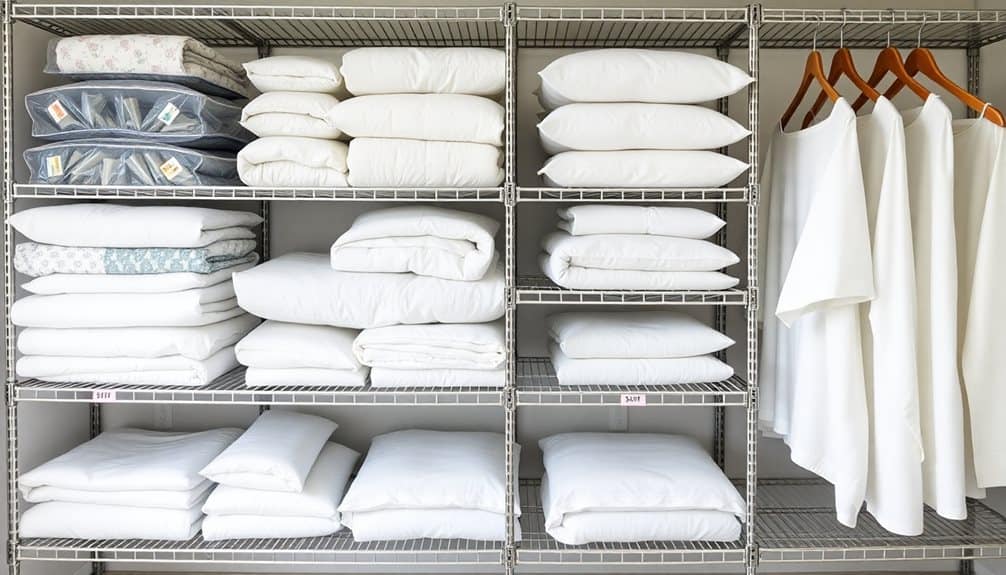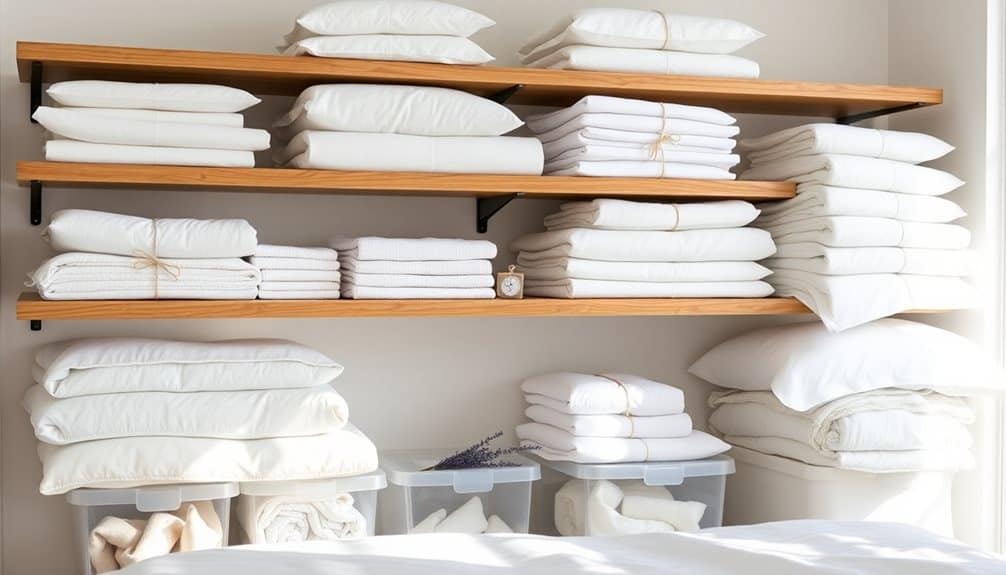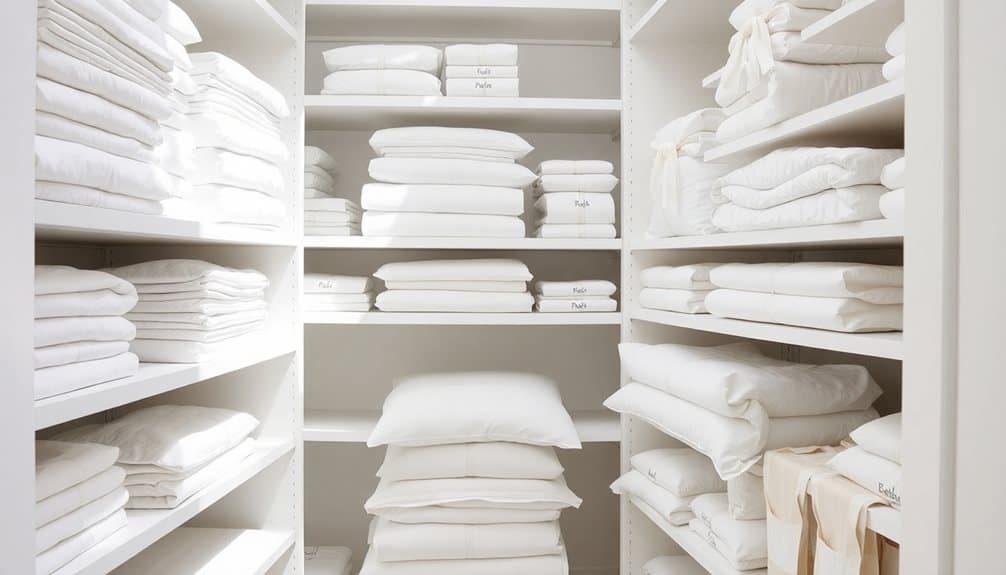This website contains affiliate links. Some products are gifted by the brand to test. As an Amazon Associate, I earn from qualifying purchases. The content on this website was created with the help of AI.
Transform your chaotic linen closet into an organized oasis by sorting bedding into clear categories: sheets, pillowcases, duvet covers, blankets, and comforters. You’ll want to group items by bed size and season, then store them in labeled bins or vacuum-sealed bags to maximize space. Master space-saving folding techniques like the KonMari method, and use shelf dividers to keep stacks neat. Don’t forget to add cedar blocks or lavender sachets to maintain freshness. Establish a weekly cleaning schedule and rotate seasonal items to guarantee your bedding stays pristine. There’s much more to discover about creating your perfect linen organization system.
Key Takeaways
- Sort bedding by category, size, and season while maintaining at least two complete sets per bed for efficient organization.
- Store complete bedding sets inside matching pillowcases to keep sets together and easily accessible.
- Master proper folding techniques, including the fitted sheet method and vertical storage for better visibility.
- Use vacuum storage bags for off-season items and clear labeled bins for active bedding rotation.
- Maintain freshness with weekly washing schedules and proper storage using cedar blocks or lavender sachets.
Sorting and Categorizing Your Linens

Before diving into organization, you’ll need to assess and sort your entire bedding collection. Start by gathering all your bedding items in one place and separating them by category: sheets, pillowcases, duvet covers, blankets, and comforters. Within each category, sort items by bed size, from twin to king.
Create three distinct piles: keep, donate, and discard. Check each item for wear, stains, or damage. If you haven’t used certain pieces in over a year, consider donating them. Throw away items with significant tears, permanent stains, or excessive wear.
Now, group your “keep” items by season. Separate lighter materials like cotton and linen for summer use from heavier materials like flannel and wool for winter. Match coordinating sets together, ensuring each set has all necessary pieces. Count how many sets you’re keeping for each bed size.
Label everything clearly by size and season. You’ll want to maintain at least two complete sets per bed: one in use and one as backup. If you have guest rooms, keep one additional set per guest bed. This systematic approach creates a foundation for efficient organization.
Smart Storage Solutions

With your bedding properly sorted, it’s time to implement storage solutions that maximize space and accessibility. Install shelf dividers in your linen closet to prevent stacks from toppling, and use clear bins to separate seasonal items. Label everything clearly, including size, type, and season, to eliminate guesswork when searching for specific items.
Store complete bedding sets in their matching pillowcases to keep everything together. You’ll find this especially helpful during sheet changes or when preparing guest rooms. For bulky items like comforters and duvets, consider vacuum storage bags during off-seasons to reduce volume by up to 75%.
Utilize under-bed storage containers for items you don’t need frequently, but make certain they’re moisture-proof to protect your linens. Install hooks on closet doors for hanging duvet covers or regularly used items. If you’re tight on space, try over-the-door organizers or hanging shelf units. Storage cubes offer a versatile solution for maximizing vertical closet space while keeping items neatly organized.
Don’t forget to place cedar blocks or lavender sachets in your storage areas to maintain freshness and deter moths. Keep frequently used items at eye level, and store rarely used pieces on higher shelves or in more remote locations.
Folding Methods That Save Space

Proper folding techniques can dramatically reduce the space your bedding occupies while keeping items wrinkle-free and easily accessible. You’ll want to master three essential folding methods for different bedding types.
For fitted sheets, start by tucking the corners into each other to form a rectangle. Smooth out the elastic edges, then fold the sheet into thirds lengthwise. Finally, fold it into thirds again to create a compact square. For flat sheets and duvet covers, lay them flat and fold them in half lengthwise twice. Then, fold the long rectangle into thirds.
Pillowcases require a different approach. Lay them flat, fold in half lengthwise, then roll tightly from one end to the other. This method prevents wrinkles and allows you to store multiple pillowcases in a small space. For bulky comforters and quilts, use the KonMari folding method: fold in thirds lengthwise, then fold multiple times until you achieve a compact rectangle that can stand upright.
Store your folded items vertically in drawers or bins, making them visible and easy to grab without disturbing the rest of your organized bedding.
Seasonal Bedding Rotation

Rotating your bedding between seasons guarantees you’ll always have appropriate linens while maximizing storage space. This systematic approach helps preserve your bedding’s quality and keeps your linen closet organized year-round. When temperatures shift, you’ll need to swap out heavy winter duvets for lightweight summer quilts, and flannel sheets for crisp cotton ones. Under bed storage solutions can provide the perfect space-saving spot for organizing seasonal bedding items.
- Store off-season bedding in vacuum-sealed bags to protect against moisture, dust, and insects while reducing storage volume by up to 75%
- Label each storage container with the season, bed size, and contents to quickly identify what you need when it’s time to switch
- Clean all bedding thoroughly before storage – confirm items are completely dry to prevent mold and mildew
- Keep frequently used items at eye level, seasonal items on higher shelves, and rarely used pieces in harder-to-reach spots
Create a rotation schedule that aligns with your local climate patterns. You’ll want to change your bedding about two weeks before the weather alters considerably. Store winter items from late spring through early fall, and summer items from late fall through early spring.
Maintaining Fresh and Clean Bedding

Keeping up with regular bedding maintenance guarantees your sleeping environment stays hygienic and inviting. You’ll need to establish a consistent cleaning schedule that includes weekly washing of sheets and pillowcases at a minimum temperature of 140°F to eliminate dust mites and bacteria. Don’t forget to rotate your mattress every three months to guarantee even wear.
For ideal cleanliness, wash your duvet cover every two to four weeks and clean your actual duvet insert twice a year. You’ll want to tackle pillow maintenance monthly by running them through the dryer on high heat to eliminate dust and refresh the filling. For non-washable items, use a handheld vacuum with upholstery attachments to remove surface debris.
Store clean bedding in breathable cotton bags or containers with cedar blocks to prevent moisture buildup and keep moths away. When making your bed each morning, pull back the covers for 20 minutes to allow moisture to evaporate. Protect your investment with quality mattress and pillow protectors, washing them monthly. Keep a spare set of sheets readily available for quick changes, and always guarantee bedding is completely dry before storing to prevent mildew.
Frequently Asked Questions
How Often Should I Replace My Bedding Sets Entirely?
You’ll need to replace your bedding sets every 2-3 years with regular use and proper care. Signs it’s time for replacement include visible wear, fading colors, thinning fabric, or persistent stains. If you’re using high-quality materials and following care instructions carefully, your bedding might last longer. Consider having 2-3 sets in rotation to reduce wear and extend their lifespan.
What’s the Ideal Number of Bedding Sets to Own per Bed?
You’ll want three to four complete bedding sets per bed for ideal rotation and convenience. One set for the bed, one in the wash, and one or two in storage guarantees you’re always prepared. This system lets you handle unexpected messes, accommodate seasonal changes, and maintain your bedding’s longevity through regular rotation. For guest rooms, two sets typically suffice since they receive less frequent use.
Can I Store Bedding in Vacuum-Sealed Bags Long-Term Without Damage?
You can safely store bedding in vacuum-sealed bags long-term, but you’ll need to take a few precautions. Only store completely clean, dry items to prevent mildew. Choose high-quality bags with secure seals, and store them in a cool, dry place. Every 6-12 months, remove and air out your bedding, then reseal. Natural fibers like cotton and wool need occasional “breathing” to maintain their quality.
Which Bedding Materials Are Most Resistant to Dust Mites and Allergens?
Like a suit of armor against microscopic invaders, microfiber and tightly woven synthetic materials offer the best defense against dust mites and allergens. You’ll find hypoallergenic bedding made from bamboo, silk, or high-quality polyester particularly effective. Natural latex and organic cotton with a thread count above 400 also create barriers that these tiny pests can’t penetrate. For maximum protection, look for fabrics labeled as “allergen-proof” or “dust mite-proof.”
How Do I Prevent Elastic From Wearing Out in Fitted Sheets?
To extend your fitted sheets’ elastic life, rotate them weekly between uses and wash them in cold water. Don’t overdry them – remove them while slightly damp and avoid high heat settings. When storing, fold them properly without stretching the elastic bands. You’ll also want to buy sheets with high-quality, thick elastic that’s sewn into the entire sheet perimeter rather than just the corners.




